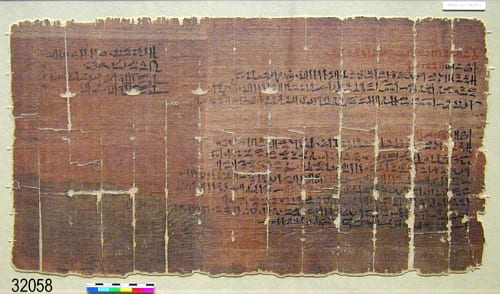There and (eventually) back again: a tale of three papyri
By Anna E Garnett, on 19 September 2017
It’s been a busy month for us at the Petrie Museum, not only gearing up for the start of the autumn term but also preparing object loans for upcoming exhibitions. Our vast collection offers many opportunities to contribute to varied exhibition narratives: our objects illustrate life in the Nile Valley over thousands of years, from Prehistory through the pharaonic period and right through to the Greco-Roman, Coptic and Islamic periods. We also hold a world-renowned collection of papyrus, which is the focus of our ongoing Papyrus for the People project funded by Arts Council England. We have loaned papyri to three very different exhibitions this September, which each tell fascinating stories of life and death in ancient Egypt.
‘Adventures in Egypt: Mrs Goodison & Other Travellers’ opens at The Atkinson, Southport, on Saturday September 23rd. This exhibition will present the story of the bustling tourist scene in Egypt in the late 19th Century, using ancient Egyptian objects and personal archives linked with pioneering female collectors, writers and excavators of that time. Amongst other objects loaned from the Petrie Museum for this exhibition is a papyrus (UC27934ii) which preserves a line drawing of a side-elevation of a shrine, from the site of Gurob, dating to around 1550-1350BC. This drawing is thought to have been made as a guide for the carpenter who would have constructed the shrine, and it is still possible to see the grid lines which the draughtsman used to make his drawing as accurate as possible. The Victorians were especially interested in technology and innovation, and this papyrus clearly shows the attention to detail of the ancient craftsmen.
‘The Museum of Ordinary Animals: the Boring Beasts that Changed the World’ opens at the Grant Museum of Zoology, UCL, on Thursday September 21st. The aim of this exhibition is to showcase the ordinary animals which make a huge impact in our lives, but which are not normally considered interesting enough to be included in natural history museum displays. As well as mummified cats, a rat-trap and fly amulets, we have lent the Petrie Museum’s Veterinary Papyrus (UC32036) to this exhibition. This papyrus, excavated from the site of Lahun by Petrie in 1889, dates to around 1850-1700BC and may be the world’s oldest text providing instructions on the care of animals, specifically cattle. The inscription gives a number of treatments for sick animals, including how to treat airborne diseases and infestations, and shows how important ‘ordinary animals’ were to the ancient inhabitants of the workmen’s town at Lahun.
Finally, ‘What does it mean to be Human? Curating Heads at UCL’ opens on Monday October 2nd in the Octagon Gallery, UCL, and tells the complex and sometimes controversial story of how science mediates the dilemma of death. This exhibition will examine the power of human remains to generate debate and critical reflection, and incorporates a range of objects and human remains from the Petrie Museum’s collection to illustrate this theme. The human story of how we approach death will be explored from different viewpoints, including thinking about the preparations we make beforehand. The act of creating a will is key to this process, and we have lent a papyrus which preserves the Will of Wah, a priest who lived in the workmen’s town at Lahun around 1850-1700BC (UC32058). This inscription tells us how Wah bequeathed his property to his wife and family, showing that women were able to inherit and own property in their own right, and that they could pass it on to their children. This papyrus therefore poses interesting questions about the ancient Egyptian approach to death in practical terms, encouraging the visitor to reflect on their own personal experiences of what it means to be human.
Anna Garnett is the Curator of the Petrie Museum of Egyptian Archaeology, UCL
 Close
Close




